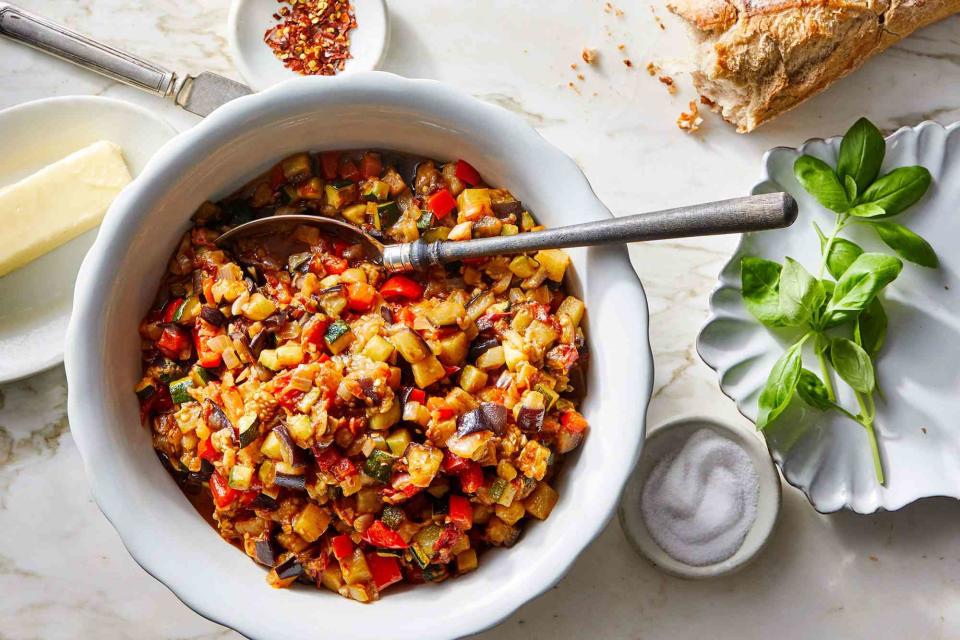Ratatouille Is a Worthwhile Labor of Love
Cooked in olive oil with garlic, herbs, and wine, this late summer vegetable stew is rich, tender, and transcendent when made well.

The moment she set down the dish on the table, I knew she had won. Even before the first bite, it was clear that through time and plenty of olive oil, the sum of my ex-girlfriend's ratatouille — a tangled, glossy jumble of eggplant, zucchini, bell peppers, onions, and tomatoes — was so much greater than its parts. There, glistening up at me, was the triumphant end to a summer in France, one we'd devoted to cooking, trying to out-ratatouille one another once and for all.
Our friendly competition had been spurred in part by an inability to go light on peak season produce at the marché, and in part by one late night viewing of the Pixar/Disney seminal 2007 delight, Ratatouille. (To clarify one disappointing and relatively overlooked cinematic detail: Remy, the movie's rodent-chef, made another Provençal classic, the tian, labeled it Ratatouille, and got away with it.) True ratatouille is a simple dish: rich, tender, and transcendent when made well; blah, watery, and mushy when not. To make one of the transcendent variety—of the sort that might warm the cold heart of a jaded food critic, for instance — prepare to spend some time in the kitchen. In other words: ratatouille should take a while.
I've made and eaten plenty of ratatouille in the years since, but my ex's version, made that summer of overflowing produce and salt-laced Mediterranean Sea breezes, continues to reign. It starts with ripe, in-season produce. In Western hemispheres, eggplants, onions, red peppers, tomatoes, and zucchini are plump, plentiful, and actually taste like something, summer through early fall. Make and eat ratatouille in abundance then. While traditional recipes call for roughly equal amounts of each vegetable, I prefer eggplant cooked this way (rendered silky and plump) too much not to bump the ratio up to two parts aubergine, one part everything else.
Then, chop. Cutting each vegetable into small-ish, uniform-ish pieces ensures they have a spot in each forkful. But there's no need to break out your ruler — ratatouille is a casual, rustic affair. It may keep you in the kitchen a while, but it wants you to relax while you're there.
Next, cook. Each vegetable should cook separately in its own bath of olive oil long enough for it to become a tender, idealized version of itself. Once each vegetable has found its prime, bring them gently together. This route, however scenic, allows flavors to mingle, layer, and roll around with each other in the final dish. Each vegetable will be perfectly cooked; each bite nuanced, dynamic, and tasting decidedly like both itself and like ratatouille.
Beside oil-pampered vegetables, garlic is a necessity, as is salting along the way. You can skip basil, but I like the subtle, earthy tone that results from a few sprigs added during cooking and taken away before serving. Also traditionally unnecessary but offered optionally in this recipe are red pepper flakes — their soft heat blooms and lingers in the final dish. You don't need the wine, but a quarter cup imbues the dish with subtle acidity, and offers an excuse to pair a glass with the cooking and the rest of the bottle with the meal.
Certainly serve ratatouille the day you cook it. However, should you have time or patience or foresight or all three, cool, cover, and refrigerate overnight then enjoy a deeper, richer ratatouille the following day. Time and patience work, yet again, in the dish's favor.
I may have lost the ratatouille-off that summer, but I share the claim to lasting victory. Each year, from the first zucchini to the final, gently bruised tomato at the bottom of the crate, I make and eat batch after batch based on that blue-ribbon recipe — sending a text and shoddily-taken photo in memory and gratitude to the person who started it all. Her summertime method became my recipe that will become, hopefully, the next ratatouille you set and share on your own table. We're all winners here.

